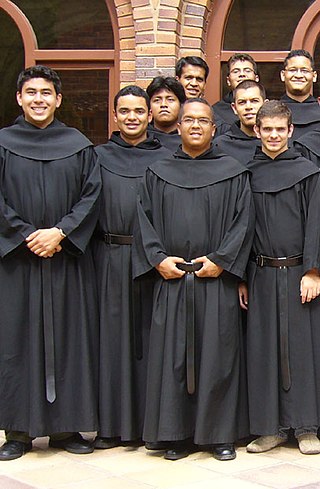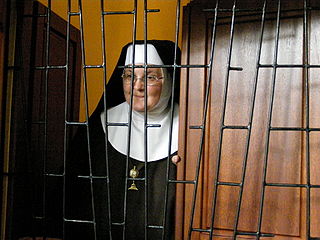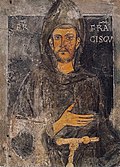
The Order of the Brothers of the Blessed Virgin Mary of Mount Carmel, known as the Carmelites or sometimes by synecdoche known simply as Carmel, is a mendicant order in the Catholic Church for both men and women. Historical records about its origin remain uncertain; it was probably founded in the 12th century on Mount Carmel in what is now Israel.

The Franciscans are a group of related mendicant religious orders of the Catholic Church. Founded in 1209 by the Italian saint Francis of Assisi, these orders include three independent orders for men, orders for nuns such as the Order of Saint Clare, and the Third Order of Saint Francis open to male and female members. They adhere to the teachings and spiritual disciplines of the founder and of his main associates and followers, such as Clare of Assisi, Anthony of Padua, and Elizabeth of Hungary. Several smaller Protestant Franciscan orders or other groups have been established since late 1800s as well, particularly in the Anglican and Lutheran traditions.

The Order of Friars Minor Capuchin is a religious order of Franciscan friars within the Catholic Church, one of three "First Orders" that reformed from the Franciscan Friars Minor Observant, the other being the Conventuals (OFMConv). Franciscans reformed as Capuchins in 1525 with the purpose of regaining the original Habit (tunic) of St. Francis of Assisi and also for returning to a stricter observance of the rule established by Francis of Assisi in 1209.

A friar is a member of one of the mendicant orders in the Roman Catholic Church. There are also friars outside of the Roman Catholic Church, such as within the Anglican Communion. The term, first used in the 12th or 13th century, distinguishes the mendicants' itinerant apostolic character, exercised broadly under the jurisdiction of a superior general, from the older monastic orders' allegiance to a single monastery formalized by their vow of stability. A friar may be in holy orders or be a non-ordained brother. The most significant orders of friars are the Dominicans, Franciscans, Augustinians, and Carmelites.

The Poor Clares, officially the Order of Saint Clare, originally referred to as the Order of Poor Ladies, and also known as the Clarisses or Clarissines, the Minoresses, the Franciscan Clarist Order, and the Second Order of Saint Francis, are members of an enclosed order of nuns in the Roman Catholic Church. The Poor Clares were the second Franciscan branch of the order to be established. The first order of the Franciscans, which was known as the Order of Friars Minor, was founded by Saint Francis of Assisi in 1209. Three years after founding the Order of Friars Minor, Francis of Assisi and Clare of Assisi founded the Order of Saint Clare, or Order of Poor Ladies, on Palm Sunday in the year 1212. They were organized after the manner of the Order of Friars Minor and before the Third Order of Saint Francis was founded. As of 2011, there were over 20,000 Poor Clare nuns in over 75 countries throughout the world. They follow several different observances and are organized into federations.

Mendicant orders are, primarily, certain Catholic religious orders that have vowed for their male members a lifestyle of poverty, traveling, and living in urban areas for purposes of preaching, evangelization, and ministry, especially to less wealthy individuals. At their foundation these orders rejected the previously established monastic model, which prescribed living in one stable, isolated community where members worked at a trade and owned property in common, including land, buildings and other wealth. By contrast, the mendicants avoided owning property at all, did not work at a trade, and embraced a poor, often itinerant lifestyle. They depended for their survival on the goodwill of the people to whom they preached. The members of these orders are not called monks but friars.

The term third order signifies, in general, lay members of Christian religious orders, who do not necessarily live in a religious community such as a monastery or a nunnery, and yet can claim to wear the religious habit and participate in the good works of a great order. Roman Catholicism, Lutheranism and Anglicanism all recognize third orders.

The Third Order of Our Lady of Mount Carmel, also known as the Lay Carmelites, is a third order of the Carmelite Order of the Ancient Observance, established in 1476 by a bull of Pope Sixtus IV. It is an association of people who choose to live the Gospel in the spirit of the Carmelite Order and under its guidance. Its members are mainly lay people.

The Order of Discalced Augustinians is a mendicant order that branched off from the Order of Saint Augustine as a reform movement.

The Discalced Carmelites, known officially as the Order of the Discalced Brothers of the Blessed Virgin Mary of Mount Carmel or the Order of Discalced Carmelites, is a Catholic mendicant order with roots in the eremitic tradition of the Desert Fathers. The order was established in the 16th century, pursuant to the reform of the Carmelite Order by two Spanish saints, Teresa of Ávila (foundress) and John of the Cross (co-founder). Discalced is derived from Latin, meaning "without shoes".
A Catholic order liturgical rite is a variant of a Catholic liturgical rite distinct from the typical ones, such as the Roman Rite, but instead specific to a certain Catholic religious order.
The Third Order of Saint Francis is a third order in the Franciscan tradition of Christianity, founded by the medieval Italian Catholic friar Francis of Assisi.

Enclosed religious orders are religious orders whose members strictly separate themselves from the affairs of the external world. The term cloistered is synonymous with enclosed. In the Catholic Church, enclosure is regulated by the code of canon law, either the Latin code or the Oriental code, and also by the constitutions of the specific order. It is practised with a variety of customs according to the nature and charism of the community in question. This separation may involve physical barriers such as walls and grilles, with entry restricted for other people and certain areas exclusively permitted to the members of the convent. Outsiders may only temporarily enter this area under certain conditions. The intended purpose for such enclosure is to prevent distraction from prayer and the religious life and to keep an atmosphere of silence.
The Society of Saint Pius X has close links with several religious institutes, chiefly in France.

The Capuchin Poor Clares is a Catholic religious order of Pontifical Right for women founded in Naples, Italy, in 1538, by Blessed Maria Lorenza Longo. The order still exists and it now has communities in the United States. Members are referred to as Capuchinesses.
When referring to Roman Catholic religious orders, the term second order refers to those communities of contemplative cloistered nuns which are a part of the religious orders that developed in the Middle Ages.

The Order of Friars Minor is a mendicant Catholic religious order, founded in 1209 by Francis of Assisi. The order adheres to the teachings and spiritual disciplines of the founder and of his main associates and followers, such as Clare of Assisi, Anthony of Padua, and Elizabeth of Hungary, among many others. The Order of Friars Minor is the largest of the contemporary First Orders within the Franciscan movement.














